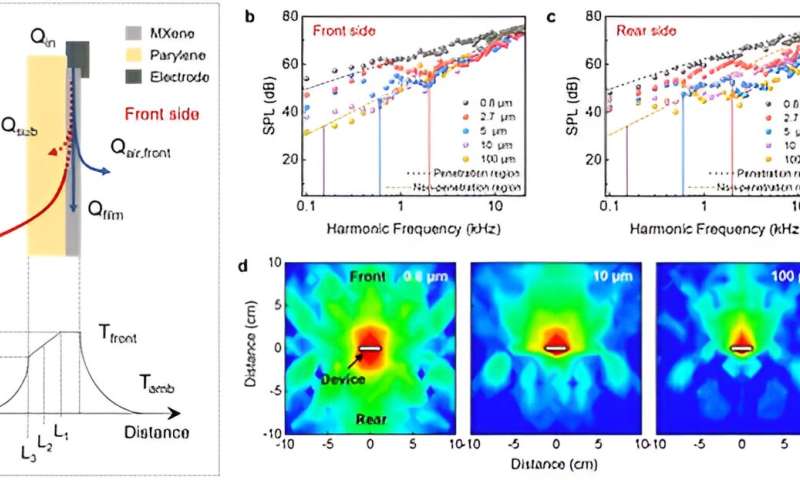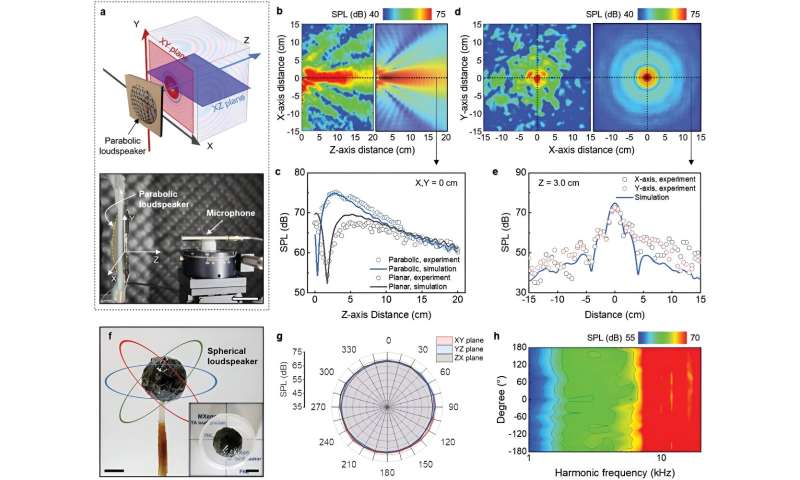This article has been reviewed according to Science X's editorial process and policies. Editors have highlighted the following attributes while ensuring the content's credibility:
fact-checked
peer-reviewed publication
trusted source
proofread
Study unveils shape-configurable MXene-based thermoacoustic loudspeakers with tunable sound directivity
![A shape-configurable MXene-based TA loudspeaker with directivity-tunable sound generation. a) Schematic illustrating the working mechanism of the flexible MXene-based TA loudspeaker. b) Conceptual sound-pressure/distance plots and sound directivities of unidirectional thick (top) and bidirectional ultrathin substrates (middle), and schematics depicting 3D sound distributions of differently configured ultrathin TA loudspeakers (cylindrical, uniaxial kirigami, parabolic, and spherical) (bottom). c) Conceptual plots of intrinsic variables (HCPUA and thermal effusivity [top]) and extrinsic variables (input power and distance [bottom]). d) Photographs showing an MXene-based TA loudspeaker with an ultrathin (0.8-µm-thick) parylene substrate (left; scale bar, 2 cm); deformable and conformal contact with a fabric electrode having a line width of 150 µm (middle; scale bar, 500 µm); and a large-area (20 cm × 20 cm) specimen (right; scale bar, 5 cm). Credit: Advanced Materials (2023). DOI: 10.1002/adma.202306637 New study unveils shape-configurable MXene-based thermoacoustic loudspeakers with tunable sound directivity](https://scx1.b-cdn.net/csz/news/800a/2023/new-study-unveils-shap.jpg)
Recent research has led to the development of film-type shape-configurable speakers. These speakers, based on the unique properties of MXene, offer tunable sound directivity and hold immense promise for the rapidly growing field of wearable electronics. The study is published in Advanced Materials.
Traditional loudspeakers with bulky vibrating diaphragms face limitations in integrating with wearable devices due to their bulky vibrating diaphragms. However, the team's ultra-thin thermoacoustic (TA) loudspeakers, which are free from such limitations, demonstrate remarkable potential in this domain. The challenge lies in configuring these speakers into arbitrary shapes due to their low sound pressure level (SPL) under mechanical deformations and limited conformability.
To overcome these challenges, the research team focused on controlling the heat capacity per unit area of the MXene conductor and the thermal effusivity of the substrates. Through this approach, they successfully developed an ultrathin MXene-based TA loudspeaker that exhibited a high SPL output of 74.5 dB at 15 kHz and maintained stable sound performance over a duration of 14 days.
A key breakthrough of this research is the ability to generate bidirectional and deformation-independent sound in various bent, twisted, cylindrical, and stretched-kirigami configurations using the parylene substrate. The parylene substrate, with a thickness smaller than the thermal penetration depth, enabled the production of speakers capable of sound output in multiple directions, regardless of their shape.
-

Effects of substrate thickness on the performance of the MXene-based TA loudspeaker. Credit: Advanced Materials (2023). DOI: 10.1002/adma.202306637 -

Sound-focusing and omnidirectional-sound-generating capabilities of the 3D MXene-based TA loudspeakers. Credit: Advanced Materials (2023). DOI: 10.1002/adma.202306637
In addition, the researchers extended their innovation to the creation of parabolic and spherical versions of ultrathin, large-area (20 cm × 20 cm) MXene-based TA loudspeakers. These speakers demonstrated sound-focusing and 3D omnidirectional-sound-generating attributes, respectively, opening up new possibilities for immersive audio experiences.
The research effort was led by Professor Hyunhyub Ko and his research team in the School of Energy and Chemical Engineering at UNIST, in collaboration with Dr. Ki-Seok An's team at the Korea Research Institute of Chemical Technology (KRICT).
Dr. Jinyoung Kim, co-first author of the study who is currently affiliated with the prestigious Georgia Institute of Technology, highlighted the exceptional performance of the MXene-based speakers. The combination of MXene's two-dimensional conductive nature and parylene's controllable thickness enables the production of thermophonic speakers with superior performance.
The ultra-thin speaker production technique developed in this study has the potential to become a key technology for various wearable devices and shape-deformation-induced sound control.
Professor Ko emphasized the wide-ranging applications of this thermal sound speaker technology. He noted, "The ability to customize device structure design and achieve shape-shifting and directional-adjustable speakers opens up possibilities for portable and home audio systems, active noise control, flexible active displays, and immersive entertainment systems."
More information: Jinyoung Kim et al, Shape‐Configurable MXene‐Based Thermoacoustic Loudspeakers with Tunable Sound Directivity, Advanced Materials (2023). DOI: 10.1002/adma.202306637
Journal information: Advanced Materials




















